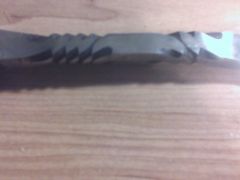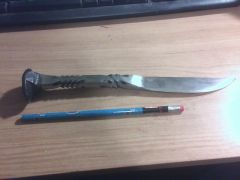-
Posts
582 -
Joined
-
Last visited
Content Type
Profiles
Forums
Articles
Gallery
Downloads
Events
Everything posted by Hillbillysmith
-
The chemicals found in the flux that I have are; Boric Acid and Borax.
-
How much do you sell those for?? Specially the first and third ones.
-
Looks good. Does it actually "drum"??
-
You can use AC on steel, but DC+ is preferred. Stick and TIG machines use constant current and yo can use an AC stick welder, right?? The only difference with stick is the flux on the filler rods, but with TIG, there are no fluxes. If you're worried about penetration, weld up a joint, I'd do a lap joint, let it cool, and break it. Don't make the weld too big and only weld one side but after breaking it, look at the to plate and If there is a jagged line, which shows where you tied in at the root, then you pass the test. If there is a distinct straight line, where the weld didn't fuse properly to the root, you fail. Just practice until you pass. Do it again with a different joint, different position. If you have any Q's about the testing, just ask. If I don't know, I'll ask my instructor. He's a certified welding inspector in several area's. But here's my best advise: GET A FOOT PEDAL!!! Or at least a rig with a finger rheostat so you can regulate the amperage.
-
Bruce, could you by any chance post some pics of that "T" shaped anvil please?? I am quite interested. :)
-
Yes, very nice. And I, too, would LOVE to know how you did the handle. Welcome to IFI. I believe that you will find it one of the best resources that you can get on the internet. Quite cozy 'round here this time of year! :)
-

Clinker Breaker Design
Hillbillysmith replied to simmonds's topic in Blacksmithing, General Discussion
Mine is triangular. At least what I think that the clinker breaker is....... -

Work tables becoming magnetized
Hillbillysmith replied to Glenn's topic in Blacksmithing, General Discussion
Build another table. Maybe some of the items on your good table get attracted to the new one and will give you more room. :) -
I think that we all should all take some time here and just send a great big thank-you out to Glenn for setting this site up for us all to come in, gather knowledge, chat with others on these subject, and for taking time out of his schedule to keep it up-to-date and to present the blueprints to us every Tuesday. This, I am sure, is not easy work and I would just like to be the first to express my appreciation for all that you have done for us Glenn. In addition to; all of the other members who put up new posts, threads, comments, etc. for the purpose of setting the rest of us up with more information that aids us in our blacksmithing endeavors. From here in NW Ohio; Thank-You, -Tony "Hillbillysmith" Turner :)
-
I would think that you could keep the costs down by making a list of several projects that you could do, everything that you need for those projects, calling around and getting the best price for the supplies, get them all in one trip/one shot, making more than one project at one time, and buying things such as grinding disks, sandpaper, belts, etc in bulk saves too. Sometimes at first, you may just have to dog it on the pay for your time. Like any other business, you may not do so hot for the first little bit, but stick with it and never give up. I think that this is a great post b/c I am currently taking a small business management course and these are the things that we are learning about, and no one every thinks about things like this and when you put things into perspective, you really don't make squat unless you know how to utilize your time properly and stretch that penny/dollar. Great post Glenn!!!
-

Are Cast Steel anvils ok?
Hillbillysmith replied to Hoary's topic in Anvils, Swage Blocks, and Mandrels
Hoary, are you registered on Anvilfire's website? It's a great site as well as IFI! Just go to Anvilfire -

Making a bowl
Hillbillysmith replied to Mr Smith's topic in BAWA Blacksmiths Association of Western Australia
Ian, you said you could make bowls out of "chain-mail". Check this out: Google Image -
Very nice. But it seems to me that you jumped the grains of stones a little too much. I would have done it more gradually. But that's just me. I don't even know if it even makes a difference in steel (cause I've only done one "mirror" finish so far), but I used to do ALOT of woodworking, and I know it does there. But please keep experimenting and PUH-LEEZE, more pics. :)
-
HW is correct. But for the recipe that you have, a 10% salt solution would be that 10% of the total solution is salt and the other 90% is water (which you know). But you can't do this in the way of gallons b/c a solid (salt) can't be properly measured in liquid (water) measurements. I, personally, would do this in the matter of weight. just figure that one gallon of water weighs approximately 8 pounds. So, lets just say you want five gallons of this salt quench. 5 gallons=40lbs. (roughly). and 10% salt would be 4lbs. Now, in true mathematical terms, this will not yield you 5 gallons. It would be more b/c you are adding to the already 5 gallons. But since the salt dissolves into the water, the volume will be the same (at least 99% the same) but the density will change. Now, the 5 gallons of water weighs approximately 44 pounds. I know its a little too drawn out, but I hope this helps. -Tony
-

Are Cast Steel anvils ok?
Hillbillysmith replied to Hoary's topic in Anvils, Swage Blocks, and Mandrels
Check this out: link removed at the request of anvilfire go to "anvil selection" -

Identifying wrought chain...?
Hillbillysmith replied to DocsMachine's topic in Blacksmithing, General Discussion
I believe that there is a chemical test that you can do that will determine what it is. But you may need a "normal" material sample. you may need to knock off some of the rust. But don't quote me on this. -

Advice for beginner!
Hillbillysmith replied to MichaelKane's topic in Blacksmithing, General Discussion
Advise? Use RR spikes! They're a great start. Best part? Lighting stuff on fire!! Worst part? Lighting yourself on fire!!! Don't ask how I know... -
AM, where do you see a temper line? I did not make one on the knife. It may just be the bevel for the edge. It has a distinct line in certain lights.
-
I am currently up to 600 grit by hand, but missed some scratches. I may have to go over it again. It is heat treated about where I want it.
-
Thanks Key, but I would like to make it a completely and totally mirror polish. I'm planning to trade it for one of my teacher's woodworkings. It's absolutely beautiful. When (if) I get it, I will surely post it. :grin:
-
I have a knife that i made a while back that I made out of SS. Not sure what grade, but I have a guess that it's 318. I have soaked it in some partially muriatic acid, and it didn't take the scale off of it. I know a grinder will take the scale off, but I don't want to use one b/c of the twisting that I have in it. What can I put this in to remove the scale? :confused: Any and all info will be greatly appreciated. Thank You All, -Tony
-
Here is a new spike knife that I have been working on. It's taken me a while to do b/c since I don't have a belt grinder, i had to file it by hand and sand it by hand. I'm not finished, but hopefully I will be soon. Feedback wanted. constructive criticism needed!! But a quick question before I get attacked (LOL): how high of sand paper should I go up to? 2000? 3000?
-
Oh! Ok. I know what you guys mean. You're referring to an open butt joint. Gotcha!!


